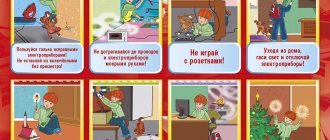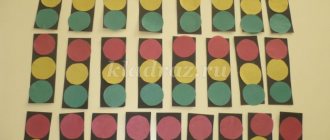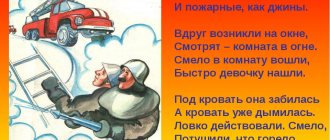Teacher Cherkasova O.N., SP5 Summary of a targeted walk to the autumn park for children of the older group.
Transcript
1 Tasks: Teacher Cherkasova O.N., SP5 Summary of a targeted walk to the autumn park for children of the older group. Goal: To expand children’s understanding of the trees and shrubs that are near us; pay attention to the nature of the city. 1. To form ideas about the importance of trees and shrubs in the life of other living organisms, including humans. To create an understanding that trees not only beautify the city, but also improve the environment. 2. Introduce children to the simplest methods of examining trees. 3. Activate children’s vocabulary by deepening their knowledge about trees: introduce them to poems, songs, riddles about trees. To develop children’s ability to name the signs of autumn, changes in the weather, and to use figurative words and expressions to describe autumn. 4. Develop cognitive interest, desire and ability to observe natural phenomena and objects, establish cause and effect relationships. 5. Foster a caring and caring attitude towards plants, a desire to care for and protect them. 6. Develop the ability to see the beauty of nature.
2 Progress of the walk Game “Find a Pair” Children are given pictures depicting natural objects. On command: “One, two, three, find yourself a mate!” Each child must find and hold hands with someone who has exactly the same picture. Then the children name what is shown in their picture and what they know about this natural object. Introductory conversation -What time of year is it? -What autumn months do you know? -What month of autumn is now? -You and I got acquainted with the signs of early autumn. And now the most beautiful time of autumn has come, golden autumn. We go on an excursion to the autumn park to see how it has changed. Did it go gold? There you and I will play, observe, learn something new for ourselves. Safety instructions: we go in pairs, we don’t run away in the park without permission, we don’t pick up foreign objects, we listen carefully to the teacher. We pass through the gates of the park. Finally, they've arrived! You can probably lie on the grass, scream at the top of your lungs, jump on the flowers, break twigs. Guys, do you agree that we need to behave this way? (Children's answers). Tell us how you will behave in the park. (Children answer). That's right, you can't tear or break anything. You can't shout or throw trash. We are visiting nature here, and when visiting we need to behave politely and respectfully. Main part (in the park) Presenter: Now we will walk through the park and observe (At the excursion site) Offer to look around. - Look at the trees and tell me what happened to the leaves? They began to turn yellow and fall off. There are fewer leaves on the trees.
3 -And now, guys, let's admire the autumn trees. Look how beautiful they are. Get closer and try to reach the lowest branch of the tree. How tall it is! This is a birch. Tell us about her. What is she like? (Children's stories.) What kind of outfit does the maple tree have? But poplar, oak. -Who will show me the tree trunk? Wrap your fingers around it. -Can you wrap your fingers around a tree trunk? Why not? What trunk? “That’s right, the trunk of the tree is thick and you can’t wrap your fingers around it.” So we'll try to do it by hand. The teacher invites 2-3 children to hold hands and hug the tree. -Guys, who will show me the branches? That's right, how thick or thin are they? -Now let's look at the leaves. What are they? (Yellow, red, orange, brown, in some places still green.) - Are the leaves large or small? Some are very small, but these are big. Let's collect leaves, but only yellow ones. Then they collect the brown ones, then only the green ones). Then, at the request of the teacher, the children collect only small leaves, then large ones. Combine the collected leaves into a single bouquet, and invite the children to watch how they smoothly and quietly spin and fall to the ground. -Let us also spin around like leaves. Well done, beautiful. Now we'll play. Game "Trees". - A strong wind is blowing - ooh-o-o-o-o-o-o-o-o-o-o-o-o-o-o-o-o-o-o-o-o-o-o-o-o-o-o-o-o-o-o-o-o-o-o-o-o-o-o-o-o-o-o-o-o-o-o-o-o-o-o-o-oh As soon as “The wind stopped,” the leaves fell (squatted down) Educator: And now I’ll tell you riddles about nature. Riddles about nature Dresses in spring, undresses in autumn (forest, park). In the summer they grow, and in the fall they fall (leaves). A friend, green and good, will help us in the rain and in the heat. He will extend to us a dozen hands and thousands of palms (tree). It breathes, grows, but cannot walk (plant). You will always find her in the forest, let’s go for a walk and meet her: Standing prickly, like a hedgehog, in winter in a summer dress (spruce, pine).
4 Do you know that there are plants whose appearance can indicate the presence of pollution in the environment. For example, when the air is polluted, the needles on the branches of spruce and pine trees turn yellow, that is, if you see that the needles on a coniferous tree have turned yellow, then the air in that place is polluted. We already know that it often rains in autumn. Now we will play another game “Sunshine and Rain” and see which of you is the most attentive. — The sun is shining, everyone is running and playing. But then it started to rain, the children ran under the umbrella. Guys, we walked around the park and watched the trees. Tell me: What trees grow in the park? (birch, aspen, bird cherry, spruce, pine, etc.) Why do they say about spruce and pine: the same color in winter and summer? (coniferous trees have needles instead of leaves, they are always green) What are the two types of trees? (coniferous and deciduous) What do they have in common? What do all trees have? (trunk, branches, roots) How can we tell trees apart? (by bark, shape of leaves) Before the children leave the park, the teacher offers to admire the beauty of the autumn park.
5 References 1. N.N. Veresov “Fundamentals of a humanitarian approach to environmental education of older preschoolers” D/V 7, 1993. 2. S.N. Nikolaeva S.N. “How to introduce a child to nature” (methodological recommendations for preschool institutions) M, 1993 3.S.N. Nikolaeva “Young ecologist” -M.: MOSAIC SYNTHESIS, I.A. Lykova “Visual activities in kindergarten” - M.: MOSAIC SYNTHESIS, O.S. Ushakova “Familiarization of preschool children with literature and speech development” - M.: TC Sfera, 2011
6 Appendix Didactic game “Find a pair and tell us what you know about the depicted object of nature” Outdoor game “Leaves and wind”
7 Didactic game “Collect only yellow leaves.” Conversation: “What do we know about trees”
8
Summary of an autumn walk in the senior group of kindergarten
Summary of a walk in the senior group on the topic: “Autumn”
Purpose: - Organize children’s recreation. Objectives: - To consolidate children’s knowledge about the changes that occur with trees in the autumn; — To consolidate children’s knowledge about trees and leaves, to enrich children’s vocabulary; — Exercise children in running, develop endurance (start running only after finishing the words); — Form in children the habit of maintaining cleanliness and order in the kindergarten area, the desire to work for the common benefit. Equipment: Children's rakes, brooms, buckets. 1. Introductory part: While walking, I ask the children a riddle: Leaves fly off the branches, Birds fly away to the south.
“What time of year is it?” - we’ll ask. They will answer us: “This is...” (autumn) - Guys, what time of year is it now? What month? (autumn, September) - How many autumn months are there? What are their names? (Three: September, October and November) - What autumn signs do you know? (cold days have arrived, it has become windy, it rains often; the leaves on the trees change color from green to yellow, orange, red, crimson; leaves are falling; insects are hiding; migratory birds are flying south; the nights have become longer and the days are short; people harvest from the fields, vegetable gardens and orchards; you need to dress warmly when you go outside, because it has become cold; the new school year has begun, the children began to go to school). — Who loves autumn and who doesn’t? Why? (children's answers) 2. Main part:
2.1.
Observing trees in autumn. I read the poem: Leaf fall, leaf fall, Yellow leaves are flying. Yellow maple, yellow beech, Yellow circle of the sun in the sky. Yellow yard, yellow house. The whole earth is yellow all around. Yellowness, yellowness, So autumn is not spring. V. Nirovich I ask the children questions: - How do trees change with the onset of autumn? —Have all the trees changed? — What is the name of the phenomenon: “falling of autumn leaves”? — What happened to the leaves? Has their color changed? — What colors are autumn leaves? Why do they change their color? I listen to the children's answers. 2.2. Individual work. I’m conducting a didactic game “Which tree did the leaf fall from?” » From oak - ... oak, From linden - ... linden, From rowan - ... rowan, From poplar - ... poplar, From aspen - ... aspen, From maple - ... maple, From birch - ... birch, From alder - ... alder. I praise children for correct answers. Didactic game “Find an extra word in each chain”, justify your choice: - spruce, rowan, tulip, maple; - poplar, birch, rose hips, oak; - rowan, apple, bird cherry, currant; - oak, aspen, spruce, linden. 2.3. Outdoor game “Burn, burn clearly” Contents of the game: I help the children stand in pairs and say the following words: Burn, burn clearly, So that it doesn’t go out Look at the sky - the birds are flying, The bells are ringing: 1, 2, 3 - run. The child runs between the pairs, chooses anyone, takes them by the hand and stands at the end of the pairs. Game continues. 2.4. Work “Cleaning leaves in a group plot.” With a subgroup of children we go to the part of the site where we will clean. I distribute rakes, brooms, and buckets to the children. To arouse interest in the upcoming activity, I use artistic words: - “Labor adorns a person”, - “Without labor there is no good”, - “Play is play, but business is business.” As work progresses, I organize and correct the children, give instructions, and monitor the quality of performance. At the end of the work, I praise the children for their efforts and ask them to assemble the equipment. 3. Final part. End of the walk. I call the children together and ask: “Guys, what did we observe today?” - What games did you play? What interesting things did you remember? I listen to the children's answers and praise them for their good work. After which I line up the children in pairs and lead them to the group.
We recommend watching:
Synopsis of a physical education lesson with children of senior preschool age Synopsis of a game lesson on the topic: Autumn for children of the senior group Synopsis of autumn leisure in a senior speech therapy group Scenario of autumn entertainment in a senior speech therapy group
Similar articles:
Summary of a lesson in the senior group on the topic “Animals in the forest in autumn”
Lesson summary on the topic “Autumn” in the senior group
Lesson on getting to know your surroundings in the senior group on an autumn theme
Walking in the senior group. Card file with goals for September
Walking in the senior group. Card index with goals for October




